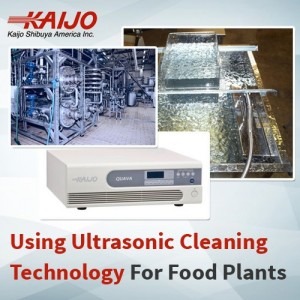Using Ultrasonic Cleaning Technology for Food Plants
January 30, 2017
 Companies that prepare or process food have extensive cleaning requirements that can be addressed with ultrasonic cleaning systems such as those offered by Kaijo. Machines, tools and even the food itself can be cleaned quickly and completely using ultrasonic cleaning baths. While machines and most tools can be cleaned with intense ultrasonic cleaning delivered at low ultrasonic frequencies, delicate food items can be cleaned at higher frequencies with less robust cleaning action. In each case, the ultrasonic system frequencies, power, bath size and transducer configuration can be matched to specific requirements for delivering effective cleaning performance.
Companies that prepare or process food have extensive cleaning requirements that can be addressed with ultrasonic cleaning systems such as those offered by Kaijo. Machines, tools and even the food itself can be cleaned quickly and completely using ultrasonic cleaning baths. While machines and most tools can be cleaned with intense ultrasonic cleaning delivered at low ultrasonic frequencies, delicate food items can be cleaned at higher frequencies with less robust cleaning action. In each case, the ultrasonic system frequencies, power, bath size and transducer configuration can be matched to specific requirements for delivering effective cleaning performance.
How Ultrasonic Cleaning Works
Ultrasonic cleaning systems consist of an ultrasonic generator, transducers and a tank for the cleaning solution and the parts to be cleaned. The generator produces the ultrasonic frequencies and is wired to the transducer, which converts the electric frequency signal to ultrasonic pressure waves in the cleaning solution. Transducers can be placed in a tank as independent units, integrated in the tank bottom or wall or bolted onto a tank. The cleaning solution can be plain water or a mild detergent can be added to help with the speedy removal of specific contaminants.
When the ultrasonic waves from the transducers travel through the cleaning solution, millions of microscopic cavitation bubbles form in the low pressure areas between the waves and collapse in the high pressure at the peaks of the waves. This collapsing of bubbles creates a strong scrubbing action that removes impurities and contaminants from the surfaces to be cleaned. The higher the frequency, the smaller are the bubbles and the gentler is the cleaning action. For companies in the food industry, metallic tools and machine parts can be cleaned of oil, grease and food residue with low frequency ultrasonic cleaners while delicate plastic parts and food can be cleaned with the gentler action of higher frequencies.
Advantages for the Food Industry
The machines and tools used by the food industry in the processing and preparation of food products require very frequent cleaning. Companies using ultrasonic cleaners obtain a competitive advantage because their cleaning is more efficient. As a result, they can reduce their maintenance costs and increase their productivity.
Ultrasonic cleaning is not only faster than traditional cleaning methods it’s also much less labor-intensive. Using ultrasonic cleaning systems, food plants can clean their equipment and resume production much faster than with mechanical scrubbing and strong solvent baths.
Secondly, ultrasonic cleaning is more effective. The bubble action of ultrasonic cleaning systems removes contaminants and foreign matter along oddly shaped pieces, within cracks and crevices and through holes. Areas that are hard to access with scrubbing pads and manual cleaning methods are no challenge for ultrasonic cleaners. The bubbles are created everywhere the cleaning solution penetrates and cleaning is even and complete.
Finally ultrasonic cleaning methods reduce chemical and solvent use. The systems clean with only plain water or with mild solvents or detergents. There is no need for soaking in strong detergents or scrubbing with abrasives. Ultrasonic cleaning can save substantial sums when these chemicals are no longer needed and the ultrasonic process is more environmentally friendly as well.
Kaijo’s Advanced Ultrasonic Cleaning Systems
Kaijo has been supplying ultrasonic cleaning systems to customers in the food industry which is helping them improve their bottom line. The company has a complete range of ultrasonic cleaning systems and can offer active support to clients in food processing plants. Customers who have specific needs can receive components, such as ultrasonic generators and transducers, that can work with the existing tanks of their traditional cleaning systems. Kaijo is helping such customers find new applications for ultrasonic cleaning in their plants and customizing equipment to fit their processes while improving performance.





